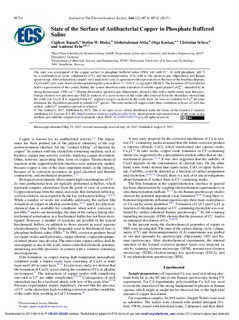| dc.contributor.author | Toparli, Cigdem | |
| dc.contributor.author | Hieke, Stefan | |
| dc.contributor.author | Altin, Abdulrahman | |
| dc.contributor.author | Kasian, Olga | |
| dc.contributor.author | Scheu, Christina | |
| dc.contributor.author | Erbe, Andreas | |
| dc.date.accessioned | 2017-08-11T07:18:21Z | |
| dc.date.available | 2017-08-11T07:18:21Z | |
| dc.date.created | 2017-08-10T10:56:18Z | |
| dc.date.issued | 2017 | |
| dc.identifier.citation | Journal of the Electrochemical Society. 2017, 164 (12), H734-H742. | nb_NO |
| dc.identifier.issn | 0013-4651 | |
| dc.identifier.uri | http://hdl.handle.net/11250/2450486 | |
| dc.description.abstract | The state was investigated of the copper surface in phosphate buffered saline (PBS; 140 mM Cl−, 10 mM phosphate; pH 7) by a combination of cyclic voltammetry (CV) and chronoamperometry (CA) with in situ spectroscopic ellipsometry and Raman spectroscopy. After polarization, samples were analyzed ex situ. In agreement with expectations on the basis of the Pourbaix diagram, Cu2O and Cu4O3 were observed when polarizing the system above ≈ −0.05 V vs. Ag|AgCl|3M KCl. The formation of Cu2O did not lead to a passivation of the system. Rather, the system dissolved under formation of soluble square planar CuCl2 −4, identified by its strong Raman peak ≈ 300 cm− 1. During dissolution, spectroscopic ellipsometry showed a film with a stable steady state thickness. Energy electron loss spectroscopy (EELS) analysis of a cross section of the oxide after removal from the electrolyte showed that the oxide was Cu2O. It is suggested that Cl− replaces oxygen vacancies in the oxide layer. As soon as oxidation to CuII becomes dominant, the dissolution proceeds to soluble CuII species. The outer surface of copper under these conditions is hence a Cu2O-like surface, with CuII complexes present in solution. | nb_NO |
| dc.language.iso | eng | nb_NO |
| dc.publisher | Electrochemical Society | nb_NO |
| dc.rights | Navngivelse 4.0 Internasjonal | * |
| dc.rights.uri | http://creativecommons.org/licenses/by/4.0/deed.no | * |
| dc.title | State of the surface of antibacterial copper in phosphate buffered saline. | nb_NO |
| dc.type | Journal article | nb_NO |
| dc.type | Peer reviewed | nb_NO |
| dc.description.version | publishedVersion | nb_NO |
| dc.source.pagenumber | H734-H742 | nb_NO |
| dc.source.volume | 164 | nb_NO |
| dc.source.journal | Journal of the Electrochemical Society | nb_NO |
| dc.source.issue | 12 | nb_NO |
| dc.identifier.doi | 10.1149/2.0351712jes | |
| dc.identifier.cristin | 1485324 | |
| dc.description.localcode | © The Author(s) 2017. Published by ECS. This is an open access article distributed under the terms of the Creative Commons Attribution 4.0 License (CC BY, http://creativecommons.org/licenses/by/4.0/), which permits unrestricted reuse of the work in any medium, provided the original work is properly cited. | nb_NO |
| cristin.unitcode | 194,66,35,0 | |
| cristin.unitname | Institutt for materialteknologi | |
| cristin.ispublished | true | |
| cristin.fulltext | original | |
| cristin.qualitycode | 2 | |

